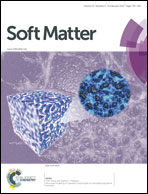Phenylboronate-diol crosslinked glycopolymeric nanocarriers for insulin delivery at physiological pH†
Abstract
Research into polymers with glucose-sensitivity in physiological conditions has expanded recently due to their therapeutic potential in diabetes. Herein, to explore the glucose-responsive properties of a new polymer under physiological conditions, we synthesized an amphiphilic block glycopolymer based on phenylboronic acid and a carbohydrate, which was named poly(D-gluconamidoethyl methacrylate-block-3-acrylamidophenylboronic acid) (p(AAPBA-b-GAMA)). Based on the cross-linking between the diol groups of the carbohydrates and phenylboronic acid, the glycopolymers self-assembled to form nanoparticles (NPs). The glucose-sensitivity was revealed by the swelling behavior of the NPs at different glucose concentrations and was found to be dependent on the glucose level. The morphology of the NPs revealed by transmission electron microscopy showed that the NPs were spherical in shape with good dispersity. The cell viability of the NPs investigated by MTT assay was more than 90%, indicating that the glycopolymers had good cytocompatibility. Insulin could be loaded onto the glycopolymer NPs with high efficiency (up to 10%), and insulin release increased with enhancement of the glucose level in the medium. Such a glucose-responsive glycopolymer is an excellent candidate that holds great potential in the treatment of diabetes.


 Please wait while we load your content...
Please wait while we load your content...